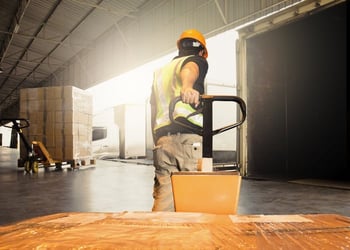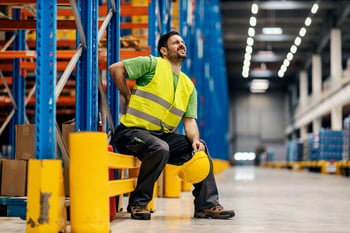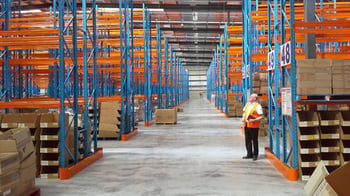Warehouses are complex operations with a lot of functions and moving parts happening simultaneously. While there are ample opportunities to improve productivity, it’s not always clear where your efforts will bear the most fruit.
 Is Motion Waste Hurting Your Warehouse Productivity?
Is Motion Waste Hurting Your Warehouse Productivity?

Article from | Newcastle Systems
Most warehouses have the goal of maximizing productivity, which has a direct impact on bottom-line results. Warehouses are complex operations with a lot of functions and moving parts happening simultaneously. While there are ample opportunities to improve productivity, it’s not always clear where your efforts will bear the most fruit.
One of the best ways to improve productivity is to address waste in your operation. A major waste type that fails to get addressed in warehouses is called motion waste. Here is what you need to know about wasted movement, how it’s harming your warehouse productivity, and some solutions to reduce motion waste in your operations.
What is Wasted Movement?
Wasted movement, also called “motion waste,” refers to unnecessary movements inside the warehouse. It can be as significant as a worker having to walk back and forth 30x per day to retrieve instructions for work tasks or as small as picking up a tool to turn off a machine. Some other examples of motion waste include:

- Constantly moving and turning to package a product
- Searching for equipment and tools
- Reaching for heavy objects placed on high or low shelves
- Walking between offices to deliver a message
Some of these movements might seem tiny, but lean methodology encourages managers to identify and eliminate them because they add up. McKinsey reports that warehouses can save up to 50% in warehousing and up to 40% in transportation by adopting lean techniques, with wasted movement being one item in this approach.
How Wasted Movement is Hurting Your Warehouse Productivity
You might be tempted to put off addressing motion waste in your warehouse. After all, you have inventory to manage, orders to fulfill, and other critical business focuses. But when you consider how wasted movement is impacting your warehouse productivity and bottom-line results, you’ll understand why it should be a priority.
Reduced Productivity
When your workers are taking more time preparing to do a task than actually doing the task, this is a serious issue. In a warehouse, there are steps employees must take before they get to the job at hand. They might need to access the picking list, find the right size box or packing materials, or get a particular tool. If you have workers walking around or searching through bins constantly, this is wasted movement that lowers productivity.
Longer Putaway, Picking, and Packing Times
Maybe you’ve tried to optimize the putaway, picking, and packing processes in your warehouse. But, if you haven’t addressed worker movement, you haven’t done all you can. These are labor-intensive tasks, so there should be an efficient use of your human resources. When you prioritize this, you can optimize these tasks further and even lower your labor costs.
Higher Employee Absenteeism Rates
When you have a labor-intensive environment, injury rates are likely going to be an issue. In fact, the Bureau of Labor Statistics reports that musculoskeletal disorders account for 29% of all workplace injuries that result in lost days from work.

These types of injuries are due to excessive bending, lifting, and repetitive motion required for work tasks. When you eliminate or minimize unnecessary tasks in your warehouse, it can lead to fewer injuries and absenteeism.
Increased Staff Turnover
Warehouses are already hurting for labor, and this industry has some of the highest turnover rates. Employees don’t like to work in inefficient workplaces. In fact, one study found that useless or inefficient tasks can have a negative effect on the mental health of workers. By addressing and eliminating wasted movement, your business will have happier employees and less turnover.
Solutions to Reduce Wasted Movement in the Warehouse
Eliminated wasted movement won’t happen overnight. But, your efforts to improve the efficiency of your operations at such an intricate level will pay off in terms of better productivity, reduced errors, and higher profits. Here are some steps and solutions to reduce wasted movement in your warehouse.
1. Identify the Causes of Wasted Movement
You may not be entirely sure where your wasted movement issues are. It might be in just one department or several. The best way to discover motion waste is to involve your employees in the conversation. Ask them where they think unnecessary movement is happening and ask for ideas about making improvements.
2. Develop New Operating Standards
The changes you implement will depend on the results you receive from the prior step. The first thing you’ll want to do is to develop some new operating standards that eliminate common types of motion waste.
Identify the materials and the minimum number of steps required to complete a task. Get your workers involved in setting these workflow standards so that you have buy-in.
3. Improve Your Warehouse Layout
Make any necessary changes to the organization and layout of your warehouse. Should some equipment, storage areas, or packing materials be closer together? Are heavy or frequently accessed items stored in the correct places? You might even be able to reduce or eliminate some motion waste by the addition of some automation tools like conveyors.

4. Leverage Technology Solutions
An obvious solution to wasted movement is to adopt technologies that automate some tasks or support hands-free operation. For example, instead of having employees walk back and forth to a central location to receive instruction, implement mobile-powered carts throughout the warehouse. These complete mobile worksites can double worker output by eliminating the need for those unnecessary trips.
Wearable devices are another option. Workers can wear a wireless headset that delivers putaway or picking instructions, eliminating the need for paper lists and clipboards.
Even after you address motion waste in your warehouse operations, it’s vital that you continue to monitor and study the issue. Continued improvement in this area of your operations can add up to greater efficiency gains and improved overall results.
To learn more, visit www.newcastlesys.com
The content & opinions in this article are the author’s and do not necessarily represent the views of ManufacturingTomorrow
Comments (0)
This post does not have any comments. Be the first to leave a comment below.
Featured Product

